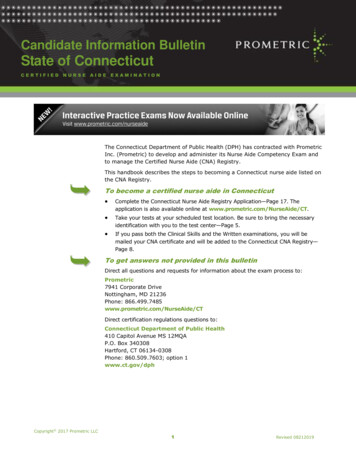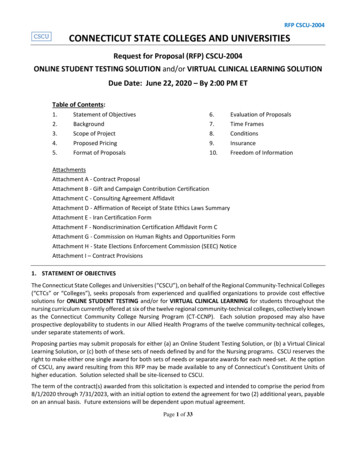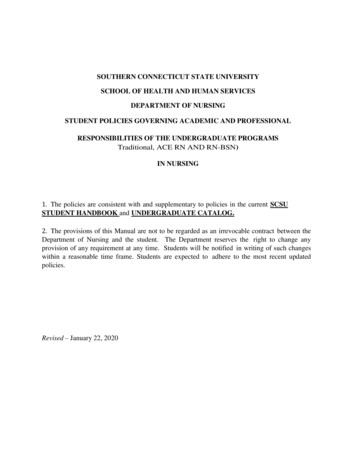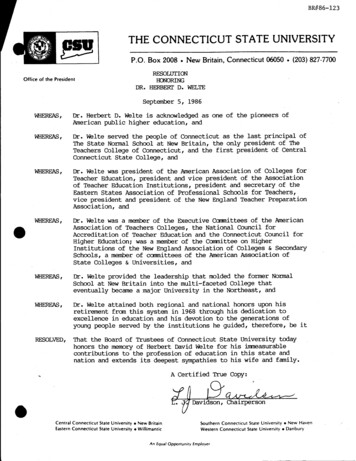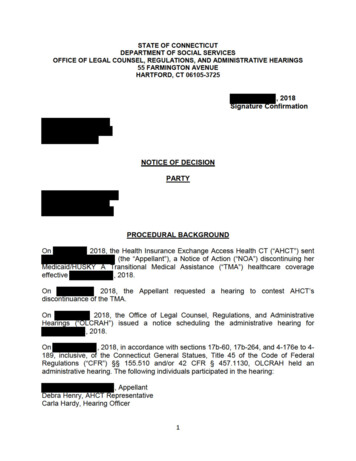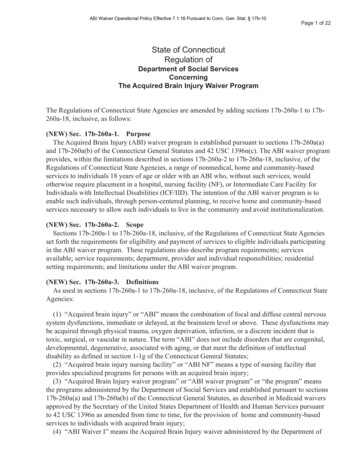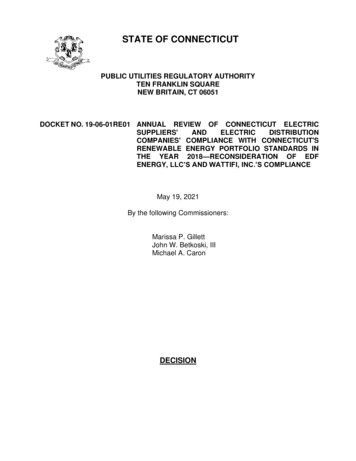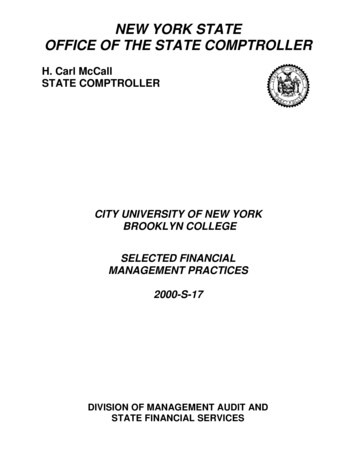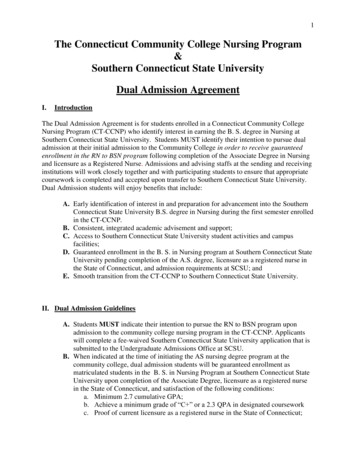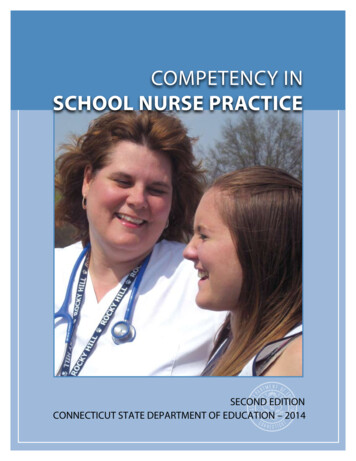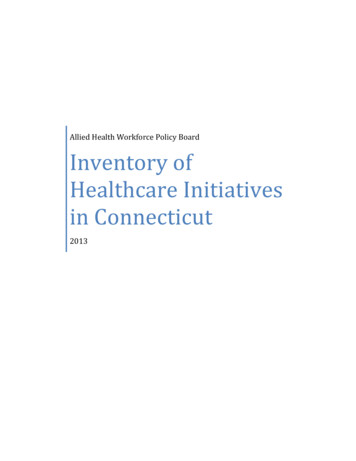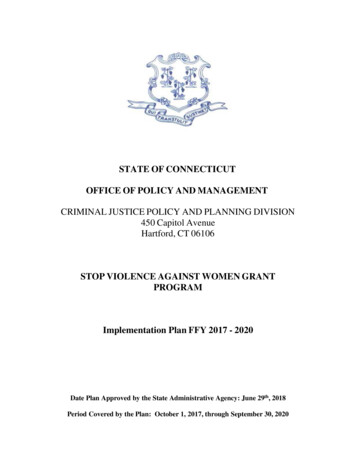
Transcription
STATE OF CONNECTICUTOFFICE OF POLICY AND MANAGEMENTCRIMINAL JUSTICE POLICY AND PLANNING DIVISION450 Capitol AvenueHartford, CT 06106STOP VIOLENCE AGAINST WOMEN GRANTPROGRAMImplementation Plan FFY 2017 - 2020Date Plan Approved by the State Administrative Agency: June 29th, 2018Period Covered by the Plan: October 1, 2017, through September 30, 2020
Table of ContentsTable of ContentsPage NumberI. IntroductionA. Summary4II. Description of Planning ProcessA. Description of Planning Process6B. Documentation from Planning Committee10C. Major Concerns12D. Description of collaboration with Other Partners13E. Coordination with FVPSA, VOCA, PHSA15III. Needs and ContextA. State Demographic Information19B. Culturally – Specific Populations24IV. Plan Priorities and ApproachesA. Identified Goals27B. Priority Areas30C. Grant Making Strategy41D. Addressing the Needs of Underserved Victims56V. AppendixA. Documentation of Collaboration Forms62B. Summary of Major Concerns69C. Letters of Support71D. State Allocation Chart92State of CT STOP Implementation PlanFFY 2017 – 2020Page 2
DefinitionsAcronymExplanationCCADVConnecticut Coalition Against Domestic ViolenceCT AllianceConnecticut Alliance to End Sexual ViolenceDSSDepartment of Social ServicesDPHDepartment of Public HealthDCJDivision of Criminal JusticeFVPSAFamily Violence Prevention Services ActOPMOffice of Policy and ManagementOVSOffice of Victim ServicesOVWOffice on Violence Against WomenPHSAPublic Health Services ActSASPSexual Assault Services ProgramSTOPServices*Training*Police*Prosecutors Formula GrantSMUSex Offender Management UnitWOCNWomen of Color NetworkState of CT STOP Implementation PlanFFY 2017 – 2020Page 3
I. IntroductionThe Violence Against Women Act, 42 U.S.C. § 13925 requires the state to developan Implementation Plan for the STOP Formula Grant Program (STOP Grant). The U.S.Department of Justice Office on Violence Against Women must approve the plan, forthe state to allocate funds to specific projects and sub-recipients. By statute, the STOPFormula Grant Program supports communities in their efforts to develop and strengtheneffective law enforcement and prosecution strategies to combat violent crimes againstwomen and to improve and enhance victim services in cases involving violent crimesagainst women. The STOP Grant provides:Services for VictimsTraining for the Criminal Justice SystemOffender AccountabilityPolice and ProsecutionThe State of Connecticut Office of Policy and Management (OPM) serves as theprimary recipient for the STOP funds and is the State Administrative Agency (SAA)responsible for the management, allocation, and oversight of the STOP federal funds atthe sub-recipient level. OVW requires the SAA to develop an Implementation Plan incollaboration with criminal justice agencies, non-governmental victim advocacyorganizations, and organizations representing underserved communities and culturallyspecific populations.Connecticut’s FFY 2017 – 2020 STOP Grant Implementation Plan identifiesgoals, objectives, and priorities for federal funds awarded to the State from the FederalFiscal Years (FFY) 2017, 2018, 2019, and 2020 STOP Formula Grant Program. TheImplementation Plan is active from the inception of the FFY 2017 federal award, October1,State of CT STOP Implementation PlanFFY 2017 – 2020Page 4
2017 through September 30, 2020. The FFY 2017 (estimated) federal STOP Grant awardis 1.8 million.Guiding Principles for STOP Grant ProgramPerwith VAWA 2013, the STOP Grant Program promotes a coordinated,multidisciplinary approach to enhancing advocacy and improving the criminal justicesystem's response to violent crimes against women. It encourages the development andimprovement of effective law enforcement and prosecution strategies to address violentcrimes against women and the development and improvement of advocacy and servicesin cases involving violent crimes against women.Use of FundsSTOP grant funds must address domestic violence, sexual assault, and stalking.The STOP grant may provide personnel, training, technical assistance, data collection,and other resources for apprehension, prosecution, and adjudication of personscommitting violent crimes against women and protection and safety of victims. (VAWA2013)The STOP grant funds must address one or more of twenty federally definedpurpose areas. In general, the purpose areas pertain to victim support and advocacyservices and core criminal justice system functions of law enforcement, prosecution,adjudication, sanctions, and accountability. A full and detailed description of thefederally defined purpose areas are available at the following onsState of CT STOP Implementation PlanFFY 2017 – 2020Page 5
II. Description of Planning ProcessA) Planning ProcessThe State Administrative Agency (SAA) developed the 2017 – 2020Implementation Plan in collaboration with non-governmental victim advocacyorganizations and criminal justice agencies. Non-profit organizations, communitymembers, and government agencies provided perspectives, opinions, and information byway of participation in the following multi-disciplinary meetings, focus groups,commission meetings, or planning sessions.The SAA expanded the planning process for the 2017 – 2020 ConnecticutImplementation Plan beyond the traditional use of a planning team, to include moreinteraction with the collaborating partners. The SAA held meetings, phone calls, focusgroups, attended events, and participated in agency-wide initiatives to integrate new ideasand expand the reach of STOP funding. The SAA along with planning meetingscompleted the following: Reviewed existing projects and conducted face-to-face meetings and phone callsto discuss challenges and collect ideas for the implementation plan. Reviewed participant feedback from STOP funded training for futureimprovements. Attended pertinent statewide Commission meetings to identify pending issues andopportunities to increase interagency collaboration. Compiled and reviewed vital statewide reports, evaluations, and advisory boardfindings that addressed violence against women issues. Held focus groups and meetings with culturally specific and underservedpopulation service providers. Attended additional OVW events and webinars to gain new ideas, goals, andobjectives for the implementation plan.State of CT STOP Implementation PlanFFY 2017 – 2020Page 6
Collaborated with OVW technical assistance provider to expand implementationplan discussions.Planning MeetingsThe SAA drafted portions of the 2017 – 2020 Implementation Plan and held face-toface meetings with the core implementation workgroup to review the components of theplan. The meetings allowed the ability for open dialogue and feedback on the goals andobjectives. At the end of each meeting participants submitted to OPM a Meeting PlanComments Form where participants could submit pending questions andcomments/feedback. The SAA reviewed the comment forms, and the input is availablewithin Appendix B. Additional follow-up with core implementation workgroup staff wasconducted electronically and by telephone. Planning meeting participants also completedcollaboration forms that are available in Appendix A.The following agencies participated in the face to face planning meetings. Additionally,section B contains descriptions of the entities function within Connecticut: State Sexual Assault Coalition: CT Alliance to End Sexual Violence State Domestic Violence Coalition: CT Coalition Against Domestic Violence Dual Domestic Violence and Sexual Assault Coalition: N/A Prosecution Entity: The Office of the Chief States Attorney A Court or State Admin. of the Courts: Judicial Court Support Services Division Population Specific Organization: Hispanic Health CouncilThe following implementation workgroup entities participated electronically: Law Enforcement Entity: New Haven Police DepartmentState of CT STOP Implementation PlanFFY 2017 – 2020Page 7
Representatives from Tribes: Mashantucket Pequot Tribal CourtThe SAA also disseminated the goals and objectives portion of the implementationplan for comments and feedback electronically to several non-profit entities and stateagency, and tribal partners that were unable to attend face-to-face meetings. The STOPPlan Participation Workbook includes a detailed list of individuals that received a copy ofthe plan and provided feedback.The SAA incorporated comments and feedback into a Draft Implementation Plan andcirculated the plan via e-mail to the planning team for review. Once approved by OVW,the final plan will be distributed to all collaborating partners via e-mail. The approvedplan will be available online to the public and disseminated to all planning participants.Listening Sessions and Work-groupsThe SAA collaborated with Connecticut’s federally recognized state coalitions,Connecticut Coalition Against Domestic Violence (CCADV) and Connecticut Alliance toEnd Sexual Violence (CT Alliance), to host various listening sessions. The focus of thelistening sessions was to identify barriers and challenges to victim advocacy forunderserved populations. The listening sessions included hearing from communityorganizations and culturally specific providers that are providing services within thecommunity.The listening sessions helped to inform the goals and priorities within this plan.The listening sessions also assisted the Coalitions in identifying next steps for projectsmoving forward. Listening sessions included Asian American service providers, Blackand African American community groups, deaf and hard of hearing providers, Hispanic /Latino organizations, and LGBTQ organizations. A list of participants is available withinthe consultation and collaboration section of the implementation plan.State of CT STOP Implementation PlanFFY 2017 – 2020Page 8
Commission Reports and Work ProductsThe SAA complied multiple reports, work products, and findings generated frominteragency and multi-disciplinary commissions, advisory councils, and work-groups.The commissions, advisory committees, and workgroups also include representation fromnon-governmental victim advocacy organizations. Criminal Justice Policy Advisory Commission (CJPAC): an interagencyexecutive branch policy planning body responsible for leading state governmentin building a more effective and cost-efficient criminal justice system. CCADVintroduced to CJPAC issues with Connecticut’s dual arrest rate. CT Allianceintroduced to CJPAC issues with backlogged rape kits and evidence collectionpolicies. Connecticut Domestic Violence Fatality Review Committee: a multidisciplinary committee of non-governmental providers and government agenciesthat conducts an examination of domestic violence fatalities to identify systemicgaps and barriers to services. CCADV released a report on 2015 and 2016 fatalityreview findings and recommendations. Dual Arrest Advisory Committee: a multi-disciplinary committee of nongovernmental providers and government agencies that met to discussConnecticut’s dual arrest rate. Chaired by CCADV the committee reviewedexisting statutes and policies, data, literature, and recommendations to reduce dualarrest within the state. Connecticut Sentencing Commission: Subcommittee on Community andVictim Needs: a multi-disciplinary committee of non-governmental providers andgovernment agencies that study: victim and survivor needs, services, andcommunity education; the registration requirements of the sex offender registry;information available to the public and law enforcement regarding sex offenders.State of CT STOP Implementation PlanFFY 2017 – 2020Page 9
Commission on Standardization of Collection of Evidence in Sexual AssaultInvestigations: Composed of representatives from prosecutors, courts, police,victim advocates and healthcare facilities. The Commission established a modelfor health care system response to sexual assault including standard protocols forcollection of evidence as well as outlined training components for agencies andproviders involved in the response. Domestic Violence Offender Program Standards Advisory Council: A multidisciplinary legislative advisory council under CJPAC tasked with reviewing,updating, and amending domestic violence offender program standards. Thecommission co-chaired by CCADV and the Judicial Branch released a report withrecommendations in January 2018.Technical AssistanceThe SAA hosted the Women of Color Network (WOCN) for a multi-day site visit.The SAA reviewed existing projects and developed new goals and objectives. WOCNconducted an interactive full-day training session with current underserved program staffto identify underserved or inadequately served populations. The findings are availablewithin the underserved section of the implementation plan.The SAA attended the Association of VAWA Administrators (AVA) sponsoreda peer-to-peer meeting to identify national best practices and additional resources forthe implementation plan. The SAA also participated in multiple OVW sponsoredwebinars and conference calls to incorporate new funding ideas and best practices intothe implementation plan.B. Documentation from Planning CommitteeEach participant in the planning committee completed a Documentation ofCollaboration form. The form contains the following: collaborating agency name, agencytype, meeting dates, and questions about the draft plan, and final draft. Appendix Aincludes the planning committee forms.State of CT STOP Implementation PlanFFY 2017 – 2020Page 10
State Sexual Assault Coalition: CT Alliance to End Sexual ViolenceCT Alliance is the State of Connecticut’s federally recognized sexual assaultcoalition that provides sexual assault victim advocacy services statewide. State Domestic Violence Coalition: CT Coalition Against Domestic ViolenceCCADV is the state of Connecticut’s federally recognized domestic violencecoalition that provides domestic violence victim advocacy servicesstatewide. Dual Domestic Violence and Sexual Assault Coalition: N/AConnecticut does not have dual domestic violence and sexual assaultcoalition. Prosecution Entity: The Office of the Chief States AttorneyConnecticut has a centralized state-run prosecution model. The Office of theChief States Attorney is responsible for statewide prosecution in thirteenjudicial districts across the state. Please note that Connecticut does not havelocal county prosecutors. A Court or State Admin. of the Courts: Judicial Branch - Court Support ServicesDivisionThe Judicial Branch - Court Support Services Division oversees pretrialservices, family services, divorce, domestic violence interventions, andprobation supervision within Connecticut’s state courts. Population Specific Organization: Hispanic Health CouncilThe Hispanic Health Council is one of the state’s largest Latino community –based organizations that provides a scope of social and family services.The following implementation workgroup entities participated electronically: Law Enforcement Entity: New Haven Police DepartmentThe New Haven Police Department is a larger city department that is activewithin several domestic violence and sexual assault strategies.State of CT STOP Implementation PlanFFY 2017 – 2020Page 11
Representatives from Tribes: Mashantucket Pequot Tribal CourtThe Mashantucket Pequot Court and pre-trial services manage a tribalcourt that handles misdemeanor tribal cases.C. Major ConcernsAppendix B contains a chart that summarizes the main issues and challengesdiscussed in planning meetings, commission meetings, and focus groups. The issues andconcerns chart documents a summary of participant’s questions and concerns along withthe ultimate resolution.D. Consultation and CollaborationTo expand the reach of consultation and collaboration, the SAA conducted phonecalls, e-mails, and face-to-face meetings to meet with new potential STOP partners. TheSAA integrated feedback from the underserved community partners, tribal court, andmember programs within the plan. The SAA also documented the potential barriers forunderserved community organizations, and the findings are present in Appendix B.With assistance from both federally recognized coalition’s the SAA was able tomeet with local community partners that are working to support the expansion ofunderserved victim services. The focus groups encompassed local community providersactively working to serve the following underserved groups; racial and ethnic minorities,LGBTQ, deaf and hard of hearing, and immigrant populations. Underserved communityproviders that were unable to attend in person meetings or focus groups were able toprovide feedback through surveys, e-mail, and phone calls.State of CT STOP Implementation PlanFFY 2017 – 2020Page 12
Consultation and Collaboration ListSexual Assault Crisis Center of EasternCTWomen and Families CenterRape Crisis Center of MilfordThe Center for Family JusticeSafe Haven of Greater WaterburyThe Center for Sexual Assault CrisisCounseling and EducationChrysalis Domestic Violence ServicesSusan B. Anthony ProjectDomestic Violence Crisis CenterStamfordThe Umbrella Center for DomesticViolence Services AnsoniaPrudence Crandall CenterInterval HouseWomen’s Support ServicesWomen’s Center of Greater DanburyDomestic Abuse Services GreenwichYWCADomestic Violence Crisis CenterNorwalkThe Umbrella Center for DomesticViolence Services North HavenDomestic Violence Program UnitedServices Inc. WillimanticNew Horizons Community HealthCenterSafe Futures New LondonDomestic Violence Program UnitedServices Inc. DayvilleState of CT STOP Implementation PlanFFY 2017 – 2020State of Connecticut Office of VictimServicesState of Connecticut Department ofSocial ServicesState of Connecticut Department ofPublic HealthState of Connecticut Judicial BranchCourt Support Services DivisionState of Connecticut Division ofCriminal JusticeUniversity of Connecticut Health CenterRachel Posner LLCCommunity Renewal TeamNational Alliance of Mental Illness(NAMI) - Connecticut ChapterSNEHA – Network for Women of SouthAsian OriginYWCA New BritainWheeler ClinicCapital Community CollegeConnecticut Women's Education andLegal Fund (CWEALF)Hispanic Health CouncilConnecticut Coalition Against DomesticViolenceConnecticut Alliance to End SexualViolenceConnecticut Police Officer Standardsand Training CouncilNew Haven Police DepartmentInterval HouseThe Network EnfieldPage 13
Tribal ConsultationFederally Recognized TribesFederally Recognized TribesMashantucket Pequot TribeMohegan Tribe of Indians ConnecticutHistorically the SAA has worked with both the Mohegan Tribal Police and theMashantucket Pequot Police. Both tribal law enforcement departments participate in thestate's Domestic Violence Lethality Assessment Protocol (LAP) program. CCADV usedSTOP law enforcement funds to train both tribal law enforcement departments.As part of the consultation process, the SAA meet with both the head judge, prosecutor,and pre-trial staff at the Mashantucket Pequot Tribal Court. There is an interest from theMashantucket Pequot Tribal Court to partner in a future legal advocacy program for tribalvictims. The SAA will continue to meet with the Mashantucket Pequot Tribal Court andfederally recognized domestic violence and sexual assault coalitions to explore a potentialpilot program during FFY 2017 – 2020. The Federally recognized tribes received thefollowing; a copy of the Draft Plan via e-mail, a comment form to submit feedback, and sitevisits when possible.State Recognized TribesState Recognized TribesEastern Pequot Tribal NationThe Golden Hill PaugussettSchaghticoke Tribal NationState of CT STOP Implementation PlanFFY 2017 – 2020Page 14
Historically the SAA has only consulted or collaborated with the federally recognizedtribes. To expand consultation, the SAA has taken the following steps to engage with thestate recognized tribes: a Letter to the Chief via mail requesting a review o
The SAA held meetings, phone calls, focus groups, attended events, and participated in agency-wide initiatives to integrate new ideas and expand the reach of STOP funding. The SAA along with planning meetings completed the following: Reviewed existing projec
